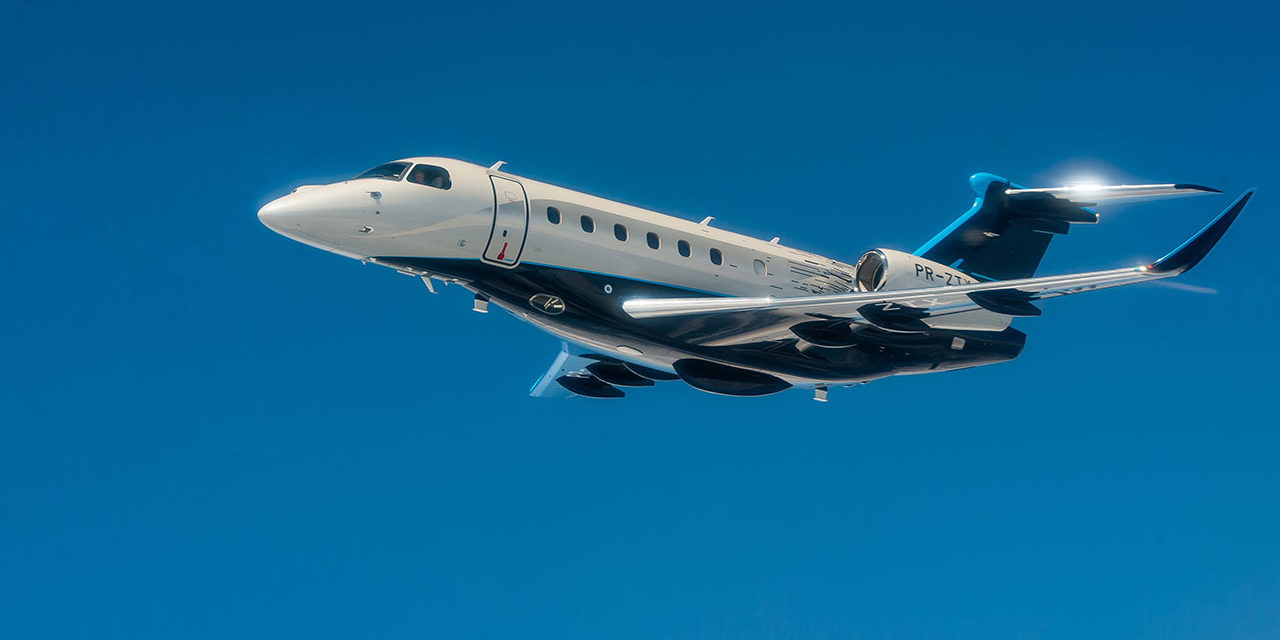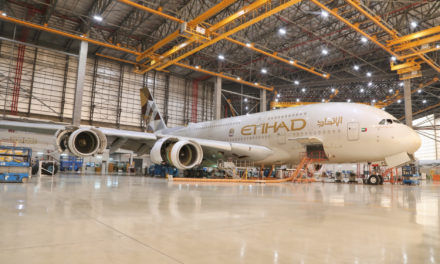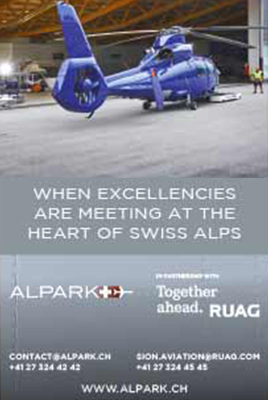Warm end-of-year reunion at the Embraer factory in Sao José dos Campos after a twenty hours journey, as I meet the brasilian team that hasn’t changed since 2008 when we first met for my first flight test on the Phenom100.
Alvadi Serpa and his development engineers are here to present their « newborn » and Camelier, Embraer chief test pilot, as well as Salgado now in charge of the company reception pilots and who will be my captain tomorrow are both attending this afternoon’s briefings on the Praetor 500/600.
I’m going to fly with the same team for the fourth time and I realize how much Embraer is a family affair as well as the company’s long journey developing their business jets portfolio in this merger context in between Boeing and Embraer commercial jets.
Why the Praetors serie?
Faithful to my habits I came in virgin of any knowledge on the aircraft and Alvadi is explaining me the whys and ifs of the serie.
Embraer decided to take customers feedback on the Legacy 450 / 500 in order to position its new serie at the top of the “midsize and super-midsize” classes.
Embraer R&D team was then put in charge of the project coordinated by Alvadi.
To be able to achieve the task it was necessary to find a way to increase the range of the aircraft, the technology on board and to increase comfort and connectivity.
With electric flight controls already available on the Legacy (unique in the midsize/super midsize classes), it remained to include the latest innovations in avionics and connectivity.
Those tasks were completed in merely 2 years of hard work!
Let’s fly the Praetor!
The next day our team meets at dawn to brief this flight which will see us take off from Sao Jose dos Campos (SBSJ) to reach the maritime areas, south of the Brazilian coast.
We quickly get to the flight line after a thorough briefing where the Praetor 500 and 600 are waiting for us.
We get on board the Praetor 600 registered PR-ZSU, whose air-conditioned cabin, thanks to the APU, accommodates a full test equipment for the certification phase.
I find a very clean cockpit very similar to the Legacy with a Rockwell Collins ProLine Fusion avionics and stylish side-sticks.
Salgado tells me that many avionics functions have been updated to the latest standards and we have among other novelties (some of which may be options on standard machines) new Honeywell Lasered VI IRS that allow very precise navigation in remote or oceanic areas, a predictive windshear system coupled with a new Doppler weather radar with the weather and cloud cells being displayed as well in vertical section, the CDTI (Cockpit Display of Traffic Information) which allows through the ADS-B (Automatic Dependent Surveillance Broadcast) to have on our giant screens full information on surrounding traffic allowing an improved situation awareness for pilots with reduced spacings in between aircraft and thus fuel savings, the SVGS (combination of SVS Synthetic Vision System and Flight Guidance Display and High Precision Position Monitors that reduces the Cat 1 approaches minimums from 200ft to 150ft even without a HUD-head up display).
I find my way around with the logic of the Fusion cockpit and we are ready to start with our FMS (Flight Management System) filled and our speeds automatically calculated (V1: 120, VR: 125, V2: 131) by the system depending on our weight (16900kg) and conditions of the day.
Getting started with our Auxiliary Power Unit (APU) is quick and easy; our automatic checklists are helping to make the process fluid.
I start taxiing within a few minutes. Turns without “tiller” just using some rudder inputs without differential braking are quite easy.
Capt Salgado advises me to keep one reverser just up to slow down our “mustang” a bit to taxi without using our brakes too much. At this pace we quickly get to the holding point of runway 15 of Sao José and we lign up after achieving our take-off safety briefing and with the “before take-off” checklist completed.
Takeoff
With 5700kg of fuel (out of 5920kg total fuel) our TOW ( take-off weight) is 16 629 kg and our take-off in a “de-rate” mode (with a power reduction compared to the 7528 lbs maximum thrust of our Honeywell HTF7500E) is a pleasure with a gradual but nice acceleration that makes me hang on my side-stick.
Upon rotation, a 15 degrees attitude is not enough and the Praetor accelerates. We clean up the aircraft without delay and I keep flying the plane manually during our climb accelerating from 250 to 300 kt.
The flight controls are very nice. I particularly appreciate our passive side-sticks ( they are not mechanically connected) and the auto-trim function that automatically compensates our pitch.
If the side-sticks are used simultaneously, a “dual input” audio alarm and some vibrations in the sticks are warning us; however, the priority can be taken by one of the two pilots by holding down the “AP disconnect” push button with the “Priority Left or Right” voice announcement.
Other than this button, there are 3 other push buttons: a button “press to talk” for communications, an EVS switch (Enhanced Vision System) allowing the activation of the EVS function on the HUD and a TCS (TrimControlSystem) switch for pitch compensation during approach phases.
The fully digital fly-by-wire flight controls not only make manual flying a real pleasure but allow for precise trajectories and offer multiple protections.
I engage the “autopilot” in LNAV (Lateral Navigation) / FLCH (Flight Level Change) / SPEED modes (speed or Mach number maintained by a gradual reduction of the climb attitude in coordination with the autothrottle) as we are passing FL180 and we continue our climb to the unrestricted FL370 flying over the coast and its seaside resorts then over beautiful Isla Bella.
A traffic on a converging route gives me the opportunity to view with a single click of the trackpad on the diamond: the aircraft’s altitude, speed, vsi, callsign, origin and destination… which enhances our situation awareness.
Due to ATC we stop at FL370 in 12 minutes and continue shortly thereafter to FL420 with a good 1000 feet+ VSI (FL420 is easily accessible even at maximum take-off weight).
At this level and even at .82M High Speed Cruise (with 475kt of ground speed), the range of the Praetor 600 thanks to its improved aerodynamic performances, the fuel efficiency of its engines (about 820kg / h total) and its increased fuel capacity of 13,058lbs / 5923 kg would be almost better than the range of its cousin the Legacy 500 flying in normal cruise speed (.78M)!
At this level and even in fast cruise, the very low noise level in the cabin and in the cockpit is a major comfort factor and, thanks to the pressure differential of 9.7psi allowed by the conditioning system, our maximum cabin altitude is 5800ft at 45000ft ( the Praetor’s practical ceiling) which is a prime factor for reduced fatigue during long flights.
I slow down to .76M (410kt ground speed) in LongRangeCruise and with a consumption of 630kg /h, our endurance would be 6 hours and again, Salgado stresses that the conditions of the day (ISA + 11) are not the most favorable!
Flight controls.
I bring us back down (using the Idle descent mode) to FL250 and Camelier who oversees the flight from the observer seat asks me whether I am ready to review the various flight control protections.
Small reminder: the flight controls of the Praetor series are digital fly-by-wire which is unique for the Mid Size and Super Mid Size categories.
They operate in Normal mode or in Direct mode…simple and straightforward.
The system allows in Normal law: the reduction of the pilots workload with the automatic trim, optimum trajectory, yaw correction in the event of an engine failure and of course flight envelope protections: high Alpha or angle of attack protection, high speed protection and load factor protection.
The Direct mode steps in in case we’d loose any of the previous protections and then we’d be flying a conventional aircraft without protections and would have to trim it manually.
At FL250 we work at .78M in manual control to evaluate the various functions and protections of the flight controls.
The fly-by-wire using 16 actuators (ailerons, spoilers on the wings, rudder and horizontal tail) allows for an automatic compensation on the pitch axis, controls the roll axis by maintaining a neutral spiral stability (that is to say that up to 33° of roll angle if we release our action on the side-stick, that angle is maintained and if we go beyond 33 ° then the flight controls bring back the roll angle to 33 °) while compensating laterally to avoid sideslip and, on the yaw axis, has a Yaw Damper function and help with coordination in turns.
Spoilers in Ground and Flight modes provide essential lift reductions to reduce landing distances and allow for steep approaches.
All these functions make the Praetor very simple to fly manually with great precision whatever the speed high or low, with an optimal roll rate (up to 30 ° / sec) and automatic compensation (up to + 2.5G / -1G in clean configuration).
In addition, the Fly-by-wire in its takeoff mode adapts the pitching rate for optimal rotations, in its landing mode forces the pilot to control his neutral pitch via a De-rotation function and offers the Trim Control System during the approaches (we will see it later on).
Camelier who developed the flight controls tells me that wing reinforcement because of such large winglets was not needed thanks to a “load aleviation” function. It was designed to reduce the stresses applied to the wings during high-speed turns using simultaneous aileron deflection upwards of 10 ° during those turns.
I first accelerate to the maximum Mach in operations (MMO) or .83M and try to go beyond taking a negative pitch angle while banking to 30 ° at.84M, overspeed protection is activated and the flying controls go against my order in the side-stick by pulling us on a nose up attitude with a bank action getting the wings level which keeps us below MMO / VMO. We cannot in normal law accelerate and exceed the maximum speed in dive (360kt / .90M).
Camelier tells me that angle of attack and load factor protections retain priority over the high speed protection and we get down to FL150 to continue.
Steady around 290kt we are going to check neutral spiral stability. I first make some turns with less than 33 ° AOB and when I release the side-stick, the bank angle remains the same. Meanwhile increasing the AOB beyond 60 °, the alarm “bank angle” alerts us but I can continue rolling the aircraft; when I release my action then the AOB gets automatically back to 33 °. We then intentionally reduce speed with 40%N1 while increasing our angle of attack. Our speed decreases through 110kt on top of the white speed tape (indicating 1.3VS1G) which cancels the auto-trim, activates the auto-throttle if the autopilot were engaged.
Our speed keeps on decreasing through 104kt (top of the yellow tape) and the alarm “Low speed”is activated. Reaching the red speed tape or about 100kt, the max angle of attack is reached and I go for full pitch up with the stick; the AOA no longer increases thanks to the protection and the speed settles just under 100kt.
The Praetor remains manoeuvrable and I roll the jet up to 30 °angle of bank while going downhill.
Getting back to normal flying is immediately achieved by reducing our angle of attack while putting back our wings level and increasing power; the effect is immediate with our speed increasing through the tapes.
Then Camelier asks me to bank the aircraft to 30 °while reducing power again and maintaining altitude (case of a last turn with the AOA rising). He tells me to yank the stick abruptly to the stop and maintain the action.
Our speed bleeds fast with the same alarm “low speed” and reaching max AOA, whatever pull I put on that side-stick:there’s no way I can get past that incidence and speed settles just on the red tape while I can still bank around the aircraft.
Simply putting our wings level and releasing the stick substantially decreases our angle of attack and we instantly get out of that tricky flight regime. Camelier explains that it was a choice that maintaining full back stick the aircraft would stay at max AOA resulting in a max angle climb whereas a “stick pusher” would force us to decrease the incidence below max AOA thus not achieving a max angle climb which in cases like “windshears” or to avoid a CFIT (Controlled Flight Into Terrain) is necessary.
Back to Sao Jose.
It is soon time to go back to Sao José to see how the Praetor behaves in the pattern and upon landing.
The ATIS received with a click of the mouse by ACARS makes us fill in the ILS 15 in the FMS and our reference speed (Vref 117kt) is calculated automatically by the system integrating our 15000lbs landing weight. The system calculates our landing distance according to the “auto-brake” selected (as well an unseen feature in the midsize supermidsize class). In our case on a dry 8780ft runway, zero wind, 1018hpa, 26 ° C and with our landing weight, our landing distance (increased by a factor of 1.15) will be around 4615ft.
I keep flying the Praetor manually during descent up until interception of the localizer that I perform in constant deceleration from 250kt to 180kt getting our flaps down to position 2.
Camelier explains the TCS function which allows us to trim the aircraft on the pitch axis while on approach just by clicking on the red switch on top of our side-sticks.
This function completes the “auto-trim” system when we are under autopilot and reduces our workload during the approach phases flown manually while keeping the pilot at the center of the loop: while the speed is decreasing, it is necessary to increase the AOA to stay level or to adjust the rate of descent and this instinctively tells us about our flight regime at that point.
I quickly adapt to the TCS help by clicking every 6 to 10 seconds during deceleration on approach.
Captain Salgado offers me a “touch and go” with plenty of fuel remaining and I accept with a big grin.
Stabilized with gear, flaps 4 and before landing check-list completed at 500ft we quickly at get down to the minimums and at about 15ft, the “De-rotation”mode (gradual automatic decrease of the pitch near the ground) activates forcing me to begin increasing pitch towards zero which lands us smoothly. I adjust power while Salgado repositions our flaps to 1 and adjusts our pitch trim back to neutral. When he tells me “power available” I go for TOGA (Take Off Go Around power) and we instantly jump past Vref with Salgado announcing “rotate”.
Despite our 15 °nose up our mustang is climbing like crazy and I disconnect the autothrottle while intercepting 3000…well rather 3500ft where we remain configured with the flaps in position 1. We carry out the after take-off check-list and then abeam runway threshold on downwind we get the gear down and flaps 2 while waiting 40 seconds before dropping our flaps to 3, I then start our last turn and upon centerline interception we get to full flaps.
Established on final for a full stop landing with medium auto-brake and reverse idle.
I still struggle to reduce our speed to our 115kt Vref by 500ft with such a fine wing profile.
As lucky as the first time, I get us smoothly and safely on the ground and watch the Praetor decelerating just with the auto-brake. We get to a taxi speed of 20kt in less than 2200ft of runway (less than 600m)!
I vacate the runway right at the Embraer intersection and we are quickly back home with chocks on and we cut the engines out using our APU while completing our lasts checklists. The three of us take a couple of minutes to debrief the flight.
The electric flight controls and their modes are amazingly simple and everything onboard is well thought of with the drivers always kept at the center of the information loop. Manual flying is a real pleasure in the jet!
However, with the latest automation innovations available, the airplane does pretty much everything by itself.
Exterior and Interior walkaround.
We take time with Salgado for a complete exterior and interior walkaround to figure out the differences with the Legacy series.
First of all the wing, very pure with a deflection of 27 degrees and 483ft2 has a wing load of 88.78 lb / ft2 which is the best in his class; the impressive “plug and play” winglets (easily removable in case of damage) gives the Praetor 600 and 500 their sleek appearance and beautiful aerodynamic lines.
Then the Honeywell HTF7500E engines with 7528lbs maximum thrust are an optimized version of the proven HTF7000 series and are the most environmentally friendly and quiet engine in their class with a focus on easy maintenance and a very low failure rate.
Visually we can distinguish a difference between the Praetor 600 and the Legacy 500 with the bulge of the belly tank revealing an auxiliary tank (which increases the fuel capacity by 2928lb / 1328kg, the wing tanks of the 500 and 600 having an equal capacity of 13058lb / 5923Kg).
This major change mostly explains the increase in range of the Praetors serie which for 4 passengers and 300 kg of luggage represents a NewYork-London flight whatever the winds for the Praetor 600 and a New York-Los Angeles flight for the Praetor 500.
The top of the rudder also differs from the Legacy and contains a Ka-band antenna allowing data transmission in “Downlink” up to 16Mb per second and ultra-fast broadband Internet which is an unheard feature in the Mid / Super Mid size classes.
A staircase with great design easy to handle manually (and with LEDs for night access and a visual system allowing external and internal operators to see each other for safe openings) gives us access to a large cabin where comfort is paramount. The cabin plans have been modified to satisfy customers needs with new bed convertible seats, noble materials (leather, precious wood as well as metal), a “wet galley” with all amenities and a state-of-the-art kitchen are also available up front for the Praetor 600, optional for the 500 that goes with a well supplied refreshment center.The use of LEDs for cabin lighting, tables and arm holders incorporating cabin management systems but also the In Flight Entertainment System, the toilet with flush, and a 35ft3 internal luggage compartment…everything on board has been designed for optimum comfort and for an unforgettable passenger experience.
Connectivity has been fully reviewed and in addition to an HD video system, the Praetor series can have a high-speed Internet system (Gogo) and / or a satellite Ka-band system up to 16Mbps download, TV “Over IP” and other innovations related to connectivity.
The Praetor series allows Embraer to bring the best to the competition in those classes of aircraft and the result is simply thrilling!
The Praetor 600 is in the process of being certified for the first quarter of 2019, while the 500 will be certified a little later this year.
Long Live the Praetor!










